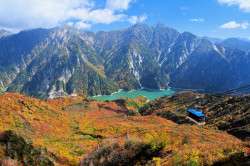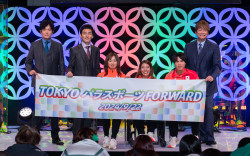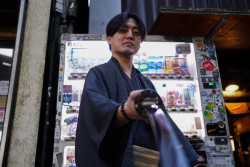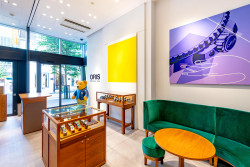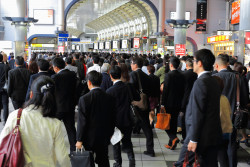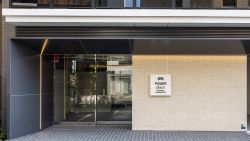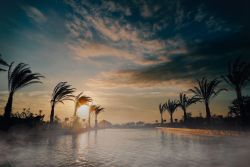
March 31, 2011
Socket to ‘Em
American car maker Tesla charges into Japan’s electric vehicle market
By Metropolis
Originally published on metropolis.co.jp on March 2011

Car photos courtesy of Tesla motors

Photo by Lorenzo Barassi

 If there is one thing that Kevin Yu loves to do, it’s drive. When you visit the Tesla Motors Asia Pacific director at his showroom in Tokyo, he is happy to take you for a spin around the block in one of his company’s colorful electric cars. Tesla opened its Aoyama showroom last November to much fanfare—Japan is the first Asian market for its lithium-ion battery-powered Roadster.
If there is one thing that Kevin Yu loves to do, it’s drive. When you visit the Tesla Motors Asia Pacific director at his showroom in Tokyo, he is happy to take you for a spin around the block in one of his company’s colorful electric cars. Tesla opened its Aoyama showroom last November to much fanfare—Japan is the first Asian market for its lithium-ion battery-powered Roadster.
The hand-built, carbon fiber electric Roadster, which comes in 14 colors, zips from 0-100 kilometers per hour in 3.7 seconds. And the tie-up with Japan is intimate. Last year, Tesla formed a partnership with Panasonic to make battery packs for electric cars, and more recently, Toyota invested $50 million in Tesla to help develop an electric version of Toyota’s RAV4 crossover vehicle.
Tesla has so far sold about 1,500 of its sports cars worldwide. In February, the Palo Alto-based company reported that its fourth-quarter net loss doubled to $51.4 million from a year earlier, as research and development costs for its upcoming Model S sedan soared. But at the same time, revenue almost doubled to $36.3 million from $18.6 million a year earlier. The future of electric vehicles, it seems, is bright.
Yu, who also oversees Tesla’s Hong Kong market, has high hopes for Japan, where consumers are already familiar with electric cars. Nissan’s Leaf and Mitsubishi’s iMiEV are proven successes, while Honda is considering plug-in versions of its Fit and Accord.
One of Yu’s challenges is to correct misperceptions about electric vehicles.
“The biggest one in general… is that [people] think electric cars do not perform as well as gasoline cars, that there’s a technical limitation that prevents electric cars from outperforming gasoline cars. That’s wrong,” he says in the company’s showroom. “Another is that, somehow, electricity is more dangerous than gasoline. I don’t see how that’s possible. Most people drive around with explosive gasoline in their car every day and think nothing of it.”
“Up until Tesla was established, and even after, many consumers thought about electric cars the same way they thought about golf carts,” he continues. “The golf cart is probably the most common electric vehicle that consumers are acquainted with. A lot of people who come into the showroom think our cars are like that, despite the fact they obviously look like sports cars.”
Prior to joining the automaker last year, Yu spent four years in Japan as head of PayPal (whose founder, Elon Musk, is Tesla’s COO). “Tesla is well-known in the US, but there was no concerted effort to get the word out in Japan until last year,” he says. “Tesla’s goal in Japan is to prepare the market for mainstream electric vehicles and change people’s mindsets about electric cars. We think the best marketing is word-of-mouth—specifically from our owners.”
On weekends, the showroom is popular, says Yu. “It has even become a tourist destination. We get people from Thailand, Taiwan, Korea—all over Asia—and more and more Europeans. You’d be surprised at how many people from Europe and the US have their first Tesla experience here in Tokyo. People who never thought about electric cars at home check it out when they walk by.
“One unique thing about our showroom is that we allow visitors to go on test drives,” he continues. “No matter who you are, if you have an interest in trying out a Tesla, you can come by and have a ride around the block. On weekends, there is a line. We don’t do that in any other country.”
The Roadster sells for between ¥12.8 million and ¥20 million, depending on options. That’s considerably more expensive than Nissan’s Leaf, for example, which sells for around ¥3 million. “If you’re looking for an economy car that seats four people, then you don’t buy the Roadster,” says Yu. “If you’re looking for a supercar that will accelerate from 0 to 100 in a third of the time that most other cars take, you buy this. When the company started, the choice was: do they want to build a car in the $30,000 price range and compromise on things like performance and range? At what point could they make an electric car that was both less expensive and performed better than gasoline cars? The answer was at the sports car level. If you look at the Ferrari 430, which accelerates from 0 to 100 in about 4.1 seconds, and you look at the Porsche 911 Turbo that costs $130,000, you realize that there is a segment in which an electric vehicle can really be the performance and value leader. The result was the Roadster that undercuts the Porsche by 15-20 percent pricewise and still goes 0-100 faster than the Ferrari.”
Currently, Tesla’s customers in Japan tend to be young entrepreneurs, mostly men, with the oldest customer in his 70s, says Yu. “Most of our owners have families, so the Roadster won’t be their only car. A number have expressed interest in buying the Model S.”
One of the factors contributing to the Roadster’s price is the battery pack, which is made in collaboration with Panasonic. “This is a good example of how quickly people can change their minds if you show them something that actually works,” Yu says. “Panasonic did not think automobiles would be an acceptable use of their batteries at first. Our engineers ended up having to take matters into their own hands, and demonstrate to Panasonic that our application was not only safe, it was revolutionary. That was in the mid-2000s. In 2010, Panasonic opened a billion-dollar factory in Osaka specifically to build batteries for electric cars, the same type they said was not suitable five years earlier. They made a strategic shift pretty quickly, all because a start-up company like Tesla did something with their technology that they had originally thought was impossible.”
The cost of Tesla cars will come down next year with the launch of the 4-door sedan. “The Model S will be our bread and butter car and will cost roughly half the price of the Roadster,” Yu says. “It will be more functional. This year will be the last year of production for the Roadster. It was made to establish the brand and help change people’s minds, rather than make us a lot of money. Remember, the company’s goal isn’t to just sell cars; it is to move the world away from oil toward electric vehicles.”
So far, Tesla has not had to advertise. “The only billboard ad is the one on top of this building. We have never paid for TV advertising or magazine ads, as far as I know, anywhere in the world. It’s almost all word of mouth. Because it is a unique product, we attract a lot of media attention. We do collaborate at certain events in various countries with companies like Tag Heuer in Europe and Herman Miller here in Tokyo.”
One area in which Tesla is looking to expand is the number of locations interested in hosting a Tesla high power charger. “There are some dedicated recharging stations but not many yet,” Yu says. “If there is a business, especially outside of Tokyo, that is interested in hosting a Tesla high power charger, we are happy to provide the equipment and installation, provided that they make it available to the public. I’d be very happy to work with them. We’ve had a lot of luck with hotels, like the Westin Tokyo and Westin Kyoto. We try to find like-minded people so we can get things done quickly.”
Right now, one way to charge your car is to plug it in at home. “The car is engineered so you can use any socket,” says Yu. “We give customers a 5-meter cord. Most convenience stores and parking lots have accessible electric sockets. You just don’t see them.”
“The car will go about 400 kilometers on a full charge. If you plug your car in overnight for about eight hours, you’ll get a full top-off by morning. Most owners decide to buy a high power charger for about ¥200,000 (plus about ¥50,000 installation fee). They put it in their garages, so they get a full charge in about three and a half hours.” For maintenance, Tesla uses “service rangers.” If something happens with a car, the owners can bring it or truck it back, or Tesla sends one of their rangers out. The owners send in the log data from the car so the rangers know what went wrong.
Looking ahead, Tesla plans to be at the Tokyo Motor Show in December. “I’m not sure what we will be displaying,” says Yu. “Obviously, I’d love to have the Model S prototype. However, since we have 17 stores in the world, the Model S is very much in demand.”
The affable Yu is in and out of the showroom most days. “To change the world, you really need to get out and meet people and demonstrate the technology. On weekends, you’ll usually find me here, too. This is a seven-day-a-week business. We want to make things happen—and quickly, and we’re all very passionate about what we are doing.”
Which means a lot of time behind the wheel. “I love driving to new places. I might drive to Karuizawa on a weekend. For one thing, it’s great advertising for the car, and second, people see that it can actually go to Karuizawa and back. While I am on the road, I can drop in at gas stations or any store or hotel that looks interesting, introduce myself and ask the owners if they would like to host a high power charger. We’ve actually had a lot of success like that.
For more information on Tesla, see www.teslamotors.com/tokyo. Chris Betros is the editor of Japan Today.
